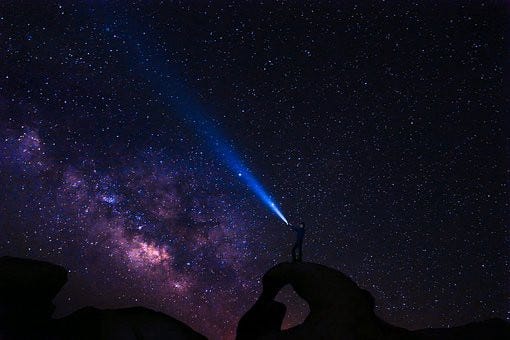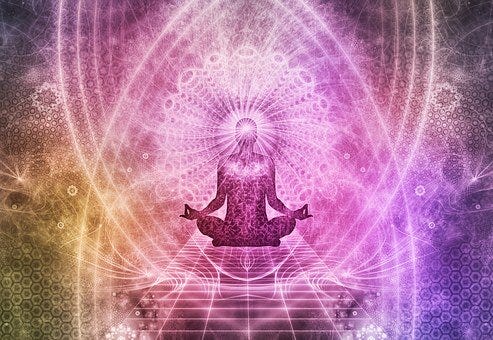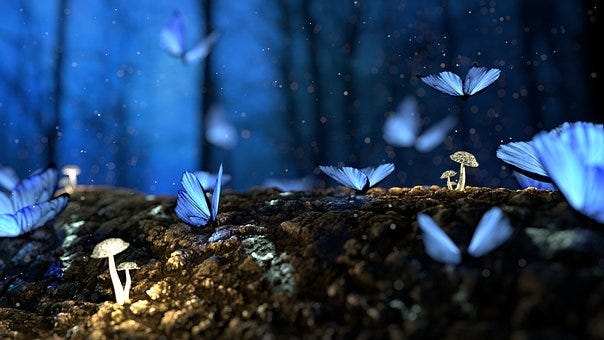
I recently published an article on Medium.com, click here, as part of an ongoing conversation between myself and Isak Dinesen on the themes of Atheism and Spirituality. (Please understand that my title here is in no way intended to refer to her, rather to those discussed below.) She calls herself a spiritual atheist, and does not believe in the existence of deities, angels, or any other type of supernatural being, since science finds no evidence for them. She therefore has said: “My universe is safe from the whims of unseen non-material influences”. My response to this was: “I would prefer to say that the universe she has chosen to believe in, and the one she personally experiences, fortunately for her, may appear to be safe in this way”. Here I was referring to the phenomenon of demonic possession (for which I believe there is compelling evidence, as described in this article). That explains this response from Jack Preston King: such people “build around themselves a mental structure that makes sense and is reliable and comforting, but it’s a house of glass. All it takes is one real demon jumping out of the bushes for their whole world to be shattered. They build their identity around protecting themselves from the mystery of the world”.
So, what we are talking about here is the contrast between the theories that one can build up in one’s mind about the nature of reality, which is what scientists do, and actual experiences which contradict these theories. There is an obvious problem when the persons involved have persuaded themselves that the theories they have constructed represent ultimate truth. They therefore tend to deny the reality of the contradictory experiences, especially when they happen to other people.
I’ll begin with an example which gives a general outline of the problem, a belief-system impervious to evidence. The late Colin Wilson was a writer sympathetic to the paranormal. In the preface to his book Afterlife¹ he tells this interesting anecdote. He had been researching some cases of poltergeists, with a view to writing a book. He then had a conversation with his publisher, who was highly sceptical: “He began to raise all the usual objections: inaccurate reporting, mischievous children, seismic disturbances, lying witnesses… I countered each objection by describing some other case in which it could not possibly apply, and he immediately thought up some new objections. After half an hour or so, I saw that nothing I could say would change his mind. As far as he was concerned, ghosts and poltergeists were a regrettable remnant of mediaeval superstition, and that was that… I had spent months studying hundreds of cases… And unless my friend could be persuaded to spend a few weeks studying the same cases, he would continue to believe that each one could be explained away as fraud or deception”.
Here, in trying to convince a sceptic of the reality of the paranormal with arguments, Wilson was banging his head against a brick wall. A personal experience, however, can sometimes do the trick. Elizabeth Lloyd Mayer opens her book Extraordinary Knowing² with a personal anecdote. She had bought an extremely valuable harp for her daughter, which was stolen. She pursued unsuccessfully all normal channels to try to locate and retrieve it. Eventually, in desperation, she consulted a dowser. With the aid of a street map, and entering an altered state of consciousness, he managed to tell her the address where the harp was located. Within three days, after offering a reward on some posters, she had the harp back.
Before this incident she described herself as a “sceptical, highly trained scientific professional”. Her reaction was to say, this changes everything. This incident completely transformed her worldview, replacing her ‘scientific’ preconceptions. She then turned her life over to researching the paranormal, including writing the great book mentioned above.
Sometimes, however, it seems that such a powerful experience makes absolutely no difference at all. I’m currently reading, Real Magic by Dean Radin³, who is one of the great scientists of our age, daring to investigate fields where others fear to tread, risking hostility and ridicule from the ‘scientific’ community for his efforts. The following account is taken from his first chapter.
Michael Shermer is a longstanding, vociferous sceptic about the paranormal. However, in his October 2014 column in Scientific American, he said: “Often I am asked if I have ever encountered something that I could not explain. What my interlocutors have in mind are… anomalous and mystifying events that suggest the existence of the paranormal or supernatural. My answer is: yes, now I have”.
He was planning to marry his fiancée, who had been close to her grandfather, who had died when she was 16. One thing of his she had kept was a 1978 transistor radio. “Shermer tried to get it to work. He put in new batteries, looked for loose connections, and tried smacking it on a hard surface, It still wouldn’t work. So he gave up and placed it in the back of a desk drawer in their bedroom”. At the wedding, his wife “was feeling sad that her grandfather wasn’t there to give her away. After the wedding ceremony, something strange happened. They heard music. They traced it to the desk drawer in the bedroom. It was the grandfather’s radio, playing a love song.
“They were stunned into silence. Finally (his wife) whispered, ‘My grandfather is here with us, I’m not alone’. The radio continued to play that evening, fell silent the next day, and never worked again. Shermer’s reaction: ‘I have to admit, it rocked me back on my heels and shook my scepticism to its core’. As a result, he wrote… : ‘(If) we are to take seriously the scientific credo to keep an open mind and remain agnostic when the evidence is indecisive or the riddle unsolved, we should not shut the doors of perception when they may be opened to us to marvel in the mysterious’ ”.
Two years later, however, he had returned to his previous dogmatic scepticism. In the same journal he wrote: “Where the known meets the unknown we are tempted to inject paranormal and supernatural forces to explain unsolved mysteries. We must resist the temptation because such efforts can never succeed, not even in principle”. Radin continues: “Shermer justified his confidence by citing Caltech physicist Sean Carroll, because Carroll concluded that the laws of physics ‘rule out the possibility of true psychic powers’. Why? Because, Shermer continued, ‘the particles and forces of nature don’t allow us to bend spoons, levitate or read minds’. Schermer “concluded with certainty that searching for paranormal or supernatural forces ‘can never succeed’ ”.
As an aside, my conclusion from the above is that the laws of physics must be inadequate, if it is claimed that they give a complete picture of the true nature of the universe. They do not take into account the nature of the psyche. The belief that the laws of physics rule out parapsychology obviously derives from the philosophy of materialism. The reality of ESP, as Radin has persuasively argued over many years, offers evidence that this philosophy is false.
He comments about Shermer that “when one encounters a belief-shattering event, it’s not uncommon to promptly forget about it, or even to deny that it ever happened. Psychologists use the term repression to describe such cases”. Another similar psychoanalytic term is defence mechanism. The psychological syndrome that modern sceptical scientists suffer from could be called the pathological fear of the irrational. They feel comfortable only in the ordered, logical world of the rational mind they choose to inhabit. They insulate themselves by denying that paranormal forces exist. Or, to repeat Jack Preston King’s words: such people “build around themselves a mental structure that makes sense and is reliable and comforting… They build their identity around protecting themselves from the mystery of the world”.
On this theme Elizabeth Mayer says: “The human psyche is organized to escape the experience of fear. We use a vast array of defenses to channel, transform, suppress, and regulate fear. When those defenses work best, they operate unconsciously. People cannot explain why they carry out behaviour which stems from workings of the unconscious mind. When they try, they often make up plausible but incorrect explanations’ ” (p102). One good example of which would be many of the ‘laws’ of science, especially Sean Carroll’s understanding of the laws of physics.
Those of a scientific mindset often accuse believers in the paranormal and supernatural of being deluded, i.e. having psychological problems. Perhaps the opposite is the case, and that it’s actually the scientists who need therapy.

Footnotes:
1. Grafton Books, 1987
2. Bantam, 2008
3. Harmony, 2018


















